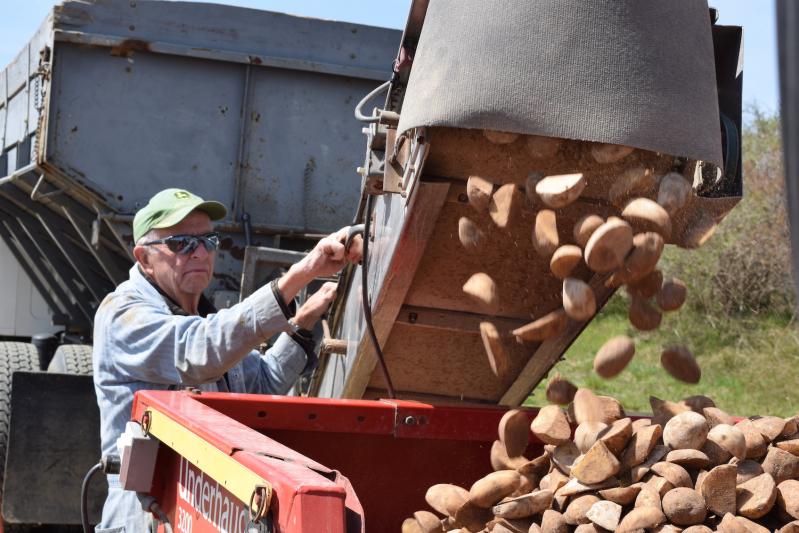THE STEADY WIND coming off the bare fields at Wesnofske Farms in Bridgehampton played the big metal equipment barn like a drum on a cloudy day in late March. Inside, planters, tractors, harvesting trucks, a plow, and a spray rig sat clean and idle, ready for another season on the South Fork’s largest remaining commercial potato farm.
In a few short weeks, Clyde Wesnofske, 81, would return from a winter in Florida to help plant the land now overseen by his sons Rick, John, and Michael, the third and possibly last generation of Wesnofskes to farm an ever-shrinking expanse of Bridgehampton fields.
“The planting equipment has all been fine-tuned. We’re basically waiting on the calendar and the weather,” John Wesnofske said from the warmth of a tidy office at the rear of the barn.
On the walls around him were his own photographs chronicling the seasons on the farm: his father by a big green tractor in one of them, neat rows of leafy green potato plants in another, the brown fields during spring planting and fall harvesting in two more.
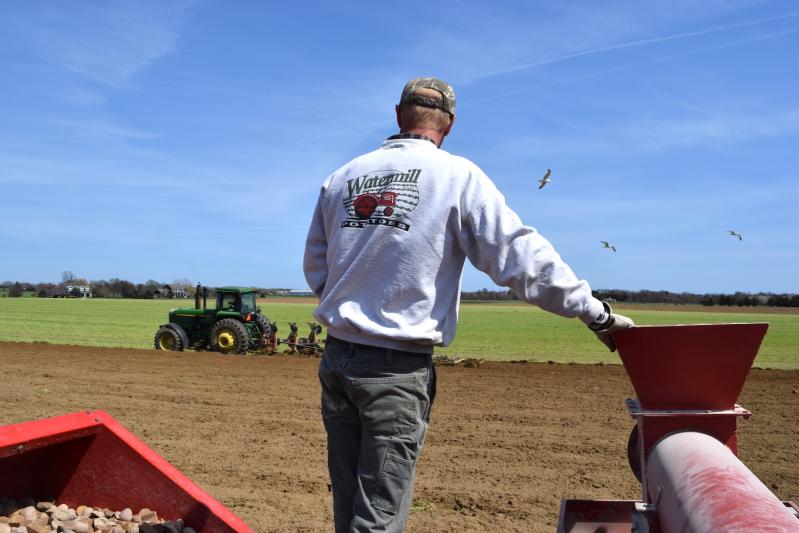
By the end of the third week of April, freezing nights and early-month rains behind them, the planting was in full swing, with father and sons working together from 7 a.m. to 7 p.m., almost 10 days straight to get seed potatoes from Maine into the South Fork soil. First the plow, up one long row, down another, then the planter, with Clyde at the wheel, following a few rows behind, dispensing potatoes and fertilizer in equal measure, transforming acre by acre from the dull brown of winter to the hopeful auburn of spring.
This year, they’re growing potatoes on 225 of the 400 or so acres they own or lease, resting the remaining land with cover crops to build up the soil.
“Years ago, when we had so many acres, we’d start toward the end of March just to get everything planted,” John said.
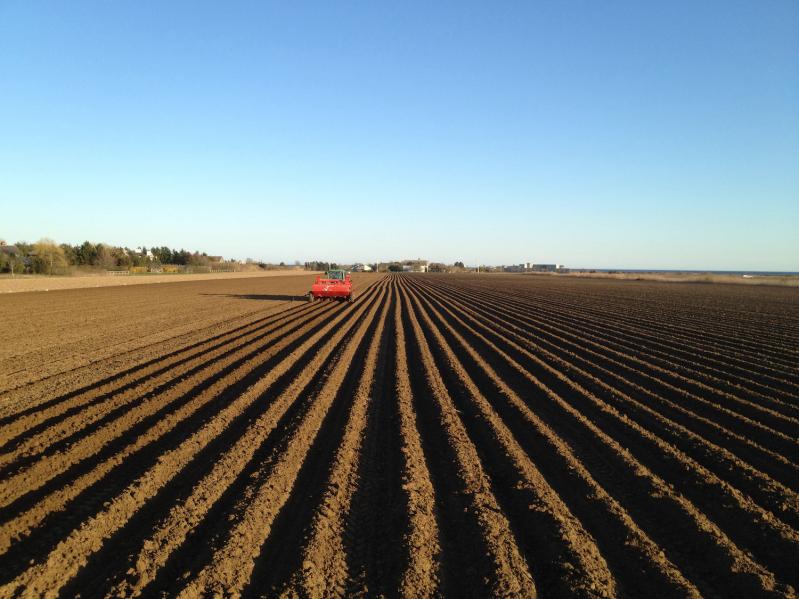
Back then, the Wesnofkes farmed close to 700 acres, including land they still own today and more that they leased. These days, it seems there is less land to rent with each passing year, cutting planting time by at least a half.
Looking north at a certain angle from the cluster of barns at the corner of Cooks Lane and Scuttlehole Road, the stretch of cultivated fields offers a glimpse into another era, when eastern Long Island was a promising new frontier for farmers squeezed off their acreage farther west on the Island by the forward march of development.
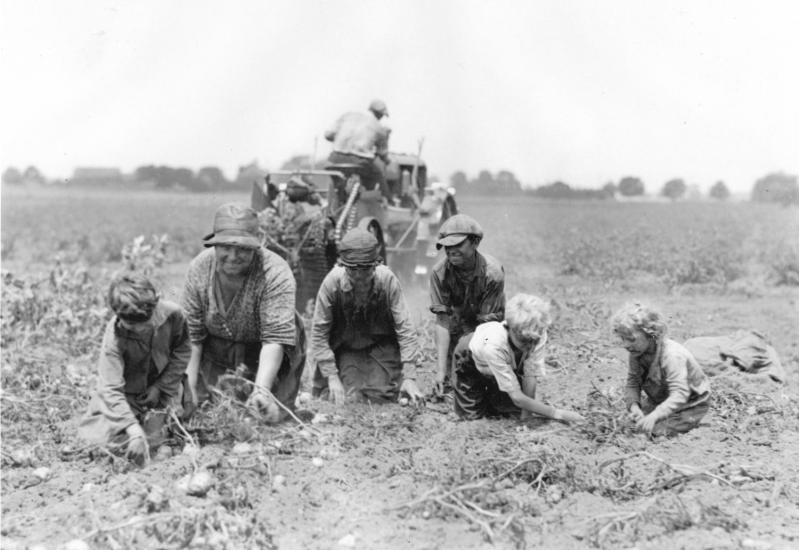
Clyde’s great-grandfather, Martin Wesnofske, emigrated from West Prussia in 1874, part of a wave of Poles leaving Europe by the hundreds of thousands at the end of the I9th century and beginning of the 2oth. He farmed in Flushing, Queens, at the edge of the Hempstead Plains. Clyde’s grandfather John Wesnofske established his own farm 10 miles west of there, in Hicksville, in 1900, and Clyde’s father, Remi, farmed in Hicksville, too, taking over the family spread with a brother before establishing one of his own nearby. As development closed in, he looked upstate, in Steuben County, and even as far as Washington State and Tennessee for better prospects.
In 1942, Remi bought the farm at the corner of Cooks Lane and Scuttlehole Road, and a decade later another farm at the intersection of Scuttlehole and Brick Kiln Roads. By 1953, he had sold his house and remaining farmland in Hicksville and settled in Bridgehampton with his wife and four children.
Having seen what happened farther west, he became one of the first Suffolk County farmers to line up behind the county’s purchase of farmland development rights in the early 1970s. “When you take farmland out of production and build on it, it’s gone forever,” Remi told the Suffolk County Legislature in 1976, after it had tabled a vote to get the program off the ground. “I farmed in Hicksville in 1952 and I saw 8o percent of good farms go to blacktop and concrete.”
But not everyone was thrilled the see the county spending tax dollars on the purchase of development rights. In fact, the program was so controversial that even after a majority of the Suffolk County Legislature finally voted in September 1976 to approve funding for the first round of acquisitions, the legislators who had voted against it filed for and won a temporary court injunction aimed at stopping the program altogether. The basis of their concern? The cost of the program in the face of an uncertain fiscal climate and that it would benefit only the East End while all of Suffolk would pay for it.
Today, aside from their house lots, all the agricultural land the Wesnofskes own is preserved. Still, even as land that can never be developed as housing, “it’s worth more now than it was for the development rights back then,” John said.
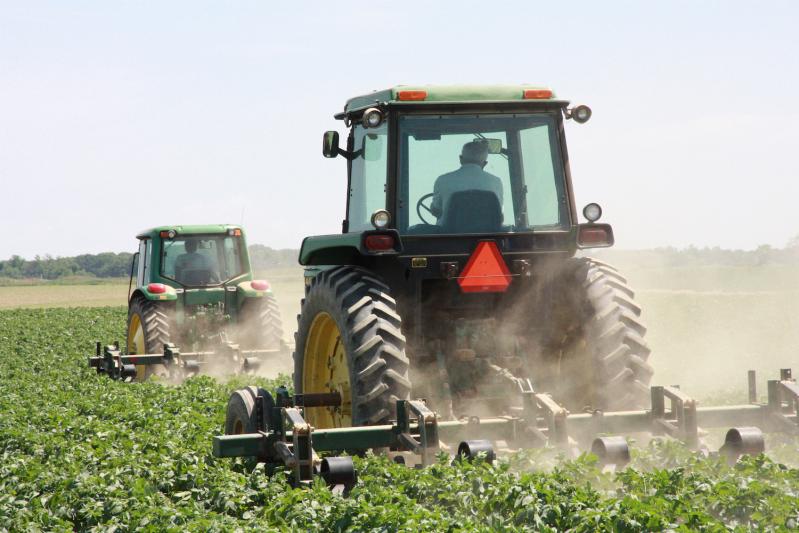
The Wesnofkes’ story — from Martin on down to Remi and Clyde and his children — is the story of agriculture on Long Island over the past century and a half, potato farming in particular.
John, Rick, and Michael are the fifth generation of Wesnofskes to raise potatoes on Long Island.
(Another brother, Robert, an engineer, lives in New Jersey.) Their sister, Victoria Corwin, works in the farm office. All four of them married the children of farmers.
“Of all the people who should have known better than to marry a potato farmer. . . .” John’s wife, Julie, joked on a visit to the barn one morning in July. Also descended from Polish immigrants, she has potato-farming roots on the South Fork that run even deeper than her husband’s, going back to her great-grand-father, Alexander Tiska, who settled in Bridgehampton just after arriving in the U.S. at the turn of the century.
Julie Wesnofske’s great-grandparents were killed in a car accident, leaving nine children, including an infant who had been in the car with them. The farm they worked so hard to establish was auctioned off and the money used to support the children, who were sent to live with different relatives. Her grandfather, Anthony Tiska St., the oldest at 14, went straight to work.
“He got into the rumrunning scene and eventually earned enough money to buy the original farm back and continued adding to it,” Julie said. Anthony Tiska St. set up some of his brothers, too, and some of his youngest siblings came to live with him. “By the time my dad inherited it from him, we owned 300 acres on Loper’s Path.” Her father, Anthony Tiska Jr., grew potatoes for more than two decades, but in 1991, Julie said, “he auctioned off all his equipment because he didn’t see any future for potato farming.” That July, “he walked into a barn with a shotgun one day and he never came out.” She was 21.
“He never got to see me marry another potato farmer.”

When she met John, it was pretty much love at first sight. “We decided to get married about three weeks after we met.” Eleven months later, they did.
Whether their son, Remi, 14, and daughter, Abby, 16, will continue in farming is anyone’s guess. “It’s too early to tell with the next generation,” John said. “I go back and forth between that’s it or it would be nice if a nephew or something wanted to take over.” He wants his children and nieces and nephews to be able to make their own decisions about their future, just as he did. “When we grew up, we didn’t come down to the farm. . . . Our parents didn’t make us farm. That’s probably why we’re farming now; they didn’t force us to do it.”
Of the brothers running Wesnofske Farms, Rick alone went to school for agriculture. John didn’t come back to the farm until after graduate school, where he earned an M.B.A. in finance. When he and his brothers decided they were ready to take over the operation, Clyde “handed it over to us pretty quickly,” John said, and mostly stepped aside to let them run it as they saw fit.
Rick has three children. The oldest, Ricky, studied engineering. His daughter, Emily, is in college, and his son Andrew will start his senior year in high school in September. Michael has three daughters, Samantha, 16, Emma, 13, and Lucy, 12.
Abby, who has her father’s smile, says she’s not interested in following in his footsteps, but when she talks about growing up on the farm and spending her summers hanging out with her cousins, it’s clear how deeply connected she is to the land she was raised on.
“The kids, they would be the fifth generation on my side of the family to farm in Bridgehampton,” Julie said. “I would love it if they kept it going.” But she knows more than anyone the challenges of the profession and the toll it can take.
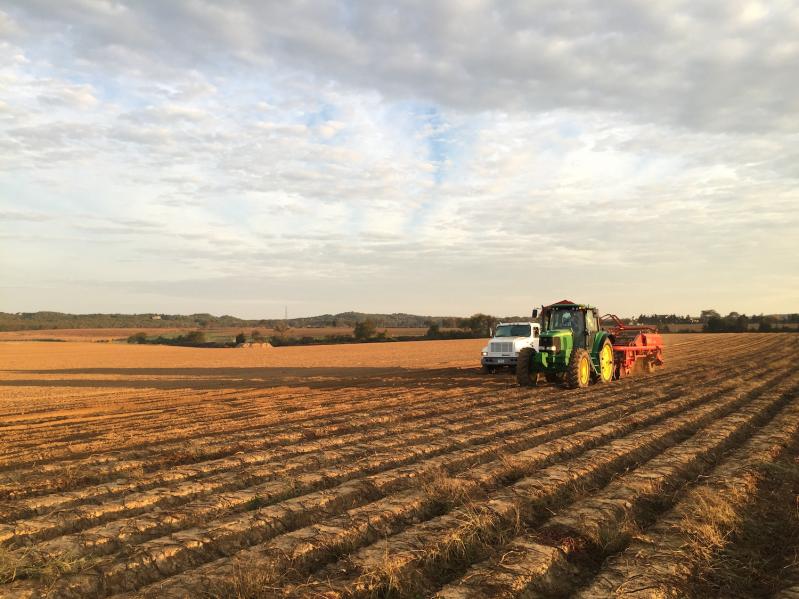
“If you don’t love it, it’s an impossible life,” she said. “You can’t move, you’re restricted in your options. There’s so many things you can’t control. Every year there are new regulations . . . the weather. . . . It doesn’t matter how hard you work some-times, and sometimes there’s not a lot of return on the work. It’s hard to start over the next year with some hope, but if you love it, you do.”
“Farmers, it’s not something they do, it’s who they are,” she said.
“Farming is still a way of life, but it’s a business, too, and if you aren’t a good businessman or woman you aren’t going to survive,” said Dale Moyer, recently retired from the Cornell Cooperative Extension of Suffolk County, where he was a vegetable and potato specialist for more than 20 years before becoming supervisor of agriculture programs. “I think folks like the Wesnofskes, that’s one reason they have survived. They understand there’s more to it than just being on a tractor: There’s marketing, economics, how you manage labor."
The Wesnofske brothers “are very good at not just doing it the way it’s always been done,” Julie said. They’re always looking at new equipment and techniques to streamline and improve their operation.
It runs in the family
“Remi, for somebody who didn’t finish high school, he picked up the knowledge of an engineer," said Ed Wesnofske, Clyde’s younger brother. Remi was an innovator in his time, Ed said: He embraced rubber tired tractors and four row planters before most would give them the time of day, used aerial photography and scientific soil maps to scout new land, and adopted mechanized processing equipment early on. He also had farms in Homestead, Fla., and later Crescent City, Fla., so there was work all year round. It was Remi who determined that it wasn’t worth it to irrigate the South Fork potato fields, and Clyde and his sons have continued that practice.
Ed is the family historian, the only one of three brothers who didn’t pursue farming. His brother Raymond, who still owns land at the corner of Scuttlehole and Brick Kiln Roads, farmed for a long time on rented land, but when that was no longer available, he turned to commercial real estate. Ed became a professor, teaching medical sociology, religion, and social change at the State University at Oneonta. He can speak eloquently about the political upheaval, social trends, and economic tides that carried the Wesnofskes from West Prussia to Queens to Nassau, where, he said, “post-World War II suburban development made it impossible to farm. ... Knowing what happened there made it possible for East End towns to seek to preserve farmland here.”
After World War II Long Island potatoes became a brand. There were as many as 70,000 acres in potato production island wide. “Long Island was famous for its potatoes," said Dale Moyer. As the cost of land and production rose, other states — Idaho, Washington, Oregon, and Maine — stepped up.
Then came the fallout, starting in the 1960s, from dealing with pests like the Colorado potato beetle and the golden nematode.
By the 1980s, Long Island potato production had declined precipitously to just 7,000 to 10,000 acres, according to Robert Carpenter, administrative director of the Long Island Farm Bureau. “The potato growers that remain are still some of the best growers left today, families that have been doing this for generations.”
Today there are fewer than 2,000 acres in potatoes on Long Is-land, making Wesnofske Farms one of the last big growers of its kind in the region. Their farm is “huge for our area," Carpenter said, while in the western U.S., a single potato farm could be 2,000 acres or larger.
On Long Island, only 50 percent of farmland is in food production today. Wine grapes have surpassed potatoes in acreage, and other non-food crops (such as nursery stock and sod) are ahead of both. But development aside, agriculture in Suffolk County is still a $240 million industry. In 2012 Suffolk County was “the third largest agriculture county in New York State in terms of dollars produced,” Carpenter said. Long number one, it was edged out by two upstate dairy counties when the yogurt boom drove dairy prices up a few years back. Those have since dropped, and by the time the next census is done in 2017, he expects Suffolk will be back at the top.
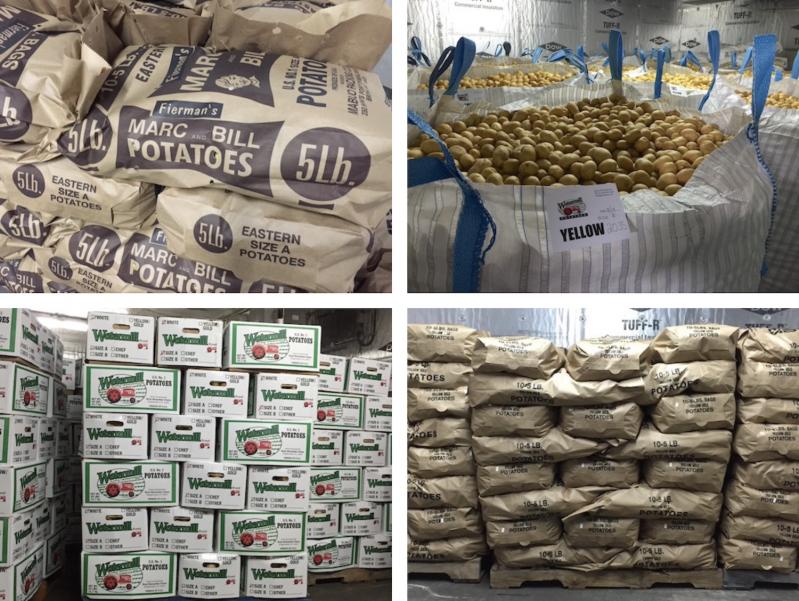
Most large South Fork farms have diversified. Not Wesnofske Farms. They’ve stopped growing corn on land not in potatoes because it didn’t make financial sense, they don’t have a farm stand, and they’ve kept their hands out of what John calls “agri-entertainment”: Tractor rides for day-trippers or U-dig potatoes aren’t their thing. They just do potatoes, and they’ve worked things out so that they get most of their weekends off, too.
“We’re taking a chance doing this one crop,” John said this spring.
“Potato farmers are kind of the dinosaurs of the farming world, but these guys, they’re really good at what they do,” his wife said.
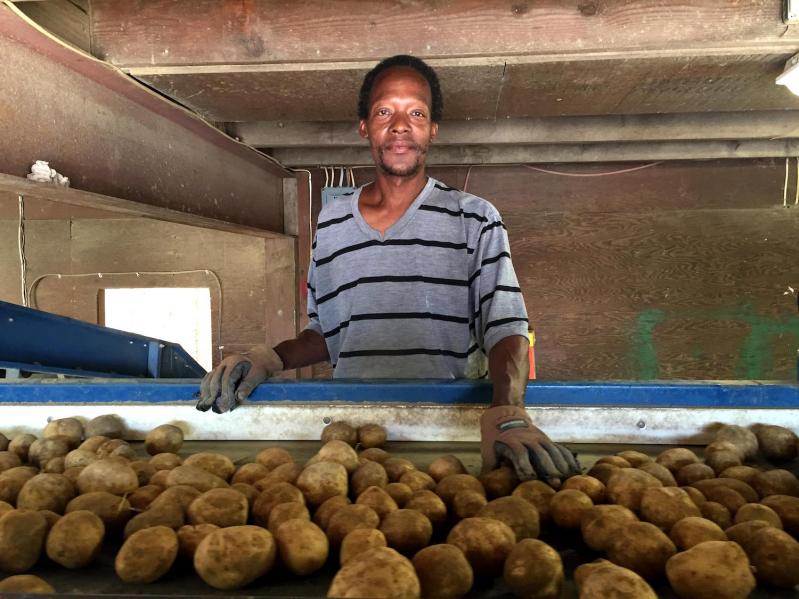
The farm supports three families, but although its barns are stocked with a fleet of specialized equipment, for much of the season you’ll find just the three brothers there handling everything. In mid-August migrant workers from Florida, most of whom have worked for the family for 15 years or so, arrive to help bring in the harvest and man the grading and packing line.
Though he’s not a farmer, John’s nephew, Victoria’s son, Jonathan Corwin, has become an integral part of the Wesnofske Farms financial equation. He works for Hapco Farms, the largest produce packager and distributor on the East Coast and the main buyer of Wesnofske potatoes.
Hapco and Joseph Firman & Son, a fruit and vegetable broker at the Hunts Point Market in the Bronx, are among the last buyers left in this area for commercial growers like the Wesnofskes.
“Without Hapco and Joseph Firman & Son, I don’t think we’d be doing it,” John said. “Someone has to buy them . . . that’s part of the problem with potatoes out this way.” The yellow and white-fleshed potatoes the Wesnofskes grow will be graded at the farm, then put in 2,000 pound totes or five pound plastic bags. Ten of those will go into a bigger master bag, and 800 of those master bags will be loaded on each tractor trailer that leaves Bridgehampton for the buyers’ distribution center. By the fall, the Wesnofskes’ potatoes will be in grocery stores around the Northeast, including Stop and Shop, Shaw’s, and Food Lion, often packed in the supermarket-brand bag. This year some will be in Long Island Stop and Shop stores under a new Island-grown labeling program that Jonathan Corwin is helping to develop.
And, plenty will end up on the Wesnofskes’ dinner tables. “When I was a kid, we had potatoes every single day,” Julie said. Not everybody will eat that many spuds, but there’s no denying potatoes are one of this country’s most popular crops. Asks John: “Have you ever met anyone that didn’t like potatoes?”
Not around here.

